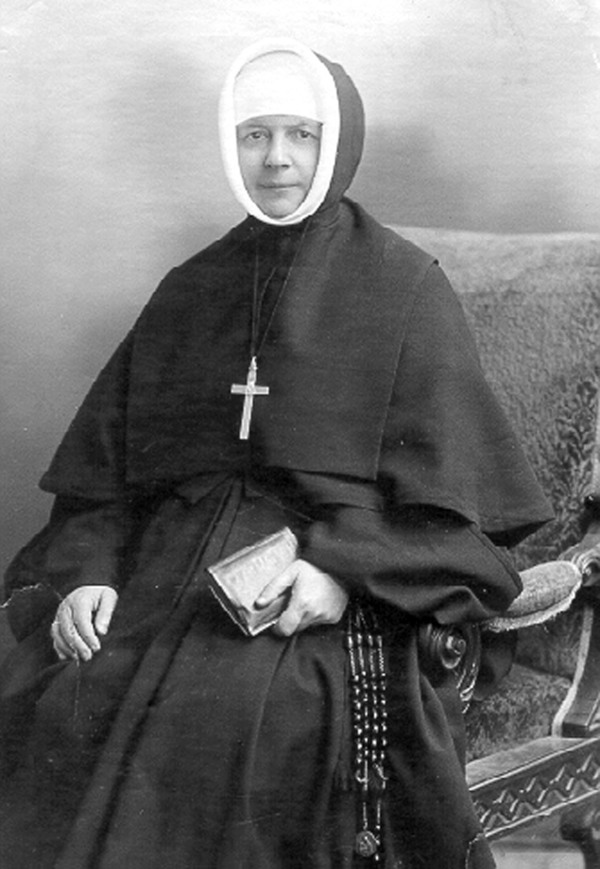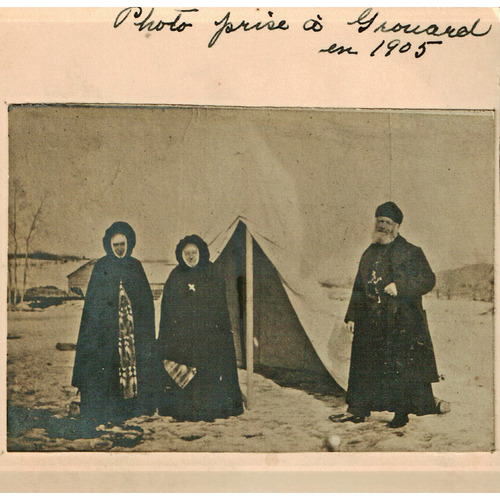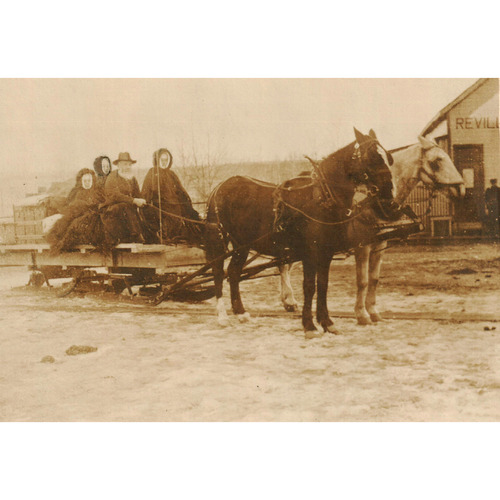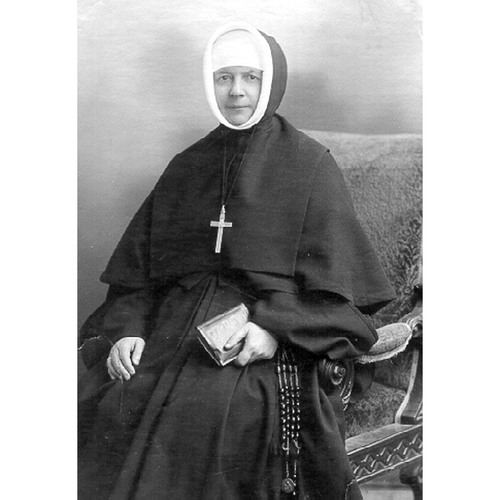
Source: Link
BLANCHARD, JULIE-MARGUERITE-LIA, named Mother Marie-Antoinette, superior general of the Sisters of Charity of Providence and author; b. 19 March 1854 in Saint-Isidore, Lower Canada, daughter of Théodore Blanchard, a joiner, and Marie-Antoinette Neveu; d. 24 Jan. 1939 in Montreal and was buried there three days later in the cemetery of the Hôpital Saint-Jean-de-Dieu.
The eldest of a family that would number 15 children, Julie-Marguerite-Lia Blanchard, nicknamed Lia, started school in the village of Saint-Isidore at the age of four. She made rapid progress, but it was her character above all that caught people’s attention. An unruly child, she nevertheless won first prize in spelling at the age of ten. According to her teacher, her talent developed through her love of reading. Lia was quick-witted, lively by nature, and had a stubborn will, traits recognized by her first noviciate instructors at the mother house of the Sisters of Charity of Providence in Montreal [see Émilie Tavernier*], which she entered at the age of 17. On 19 Nov. 1873 she made her perpetual vows and took her mother’s first names as her religious name.
Various appointments followed in rapid succession for Sister Marie-Antoinette: she taught at the Saint-Alexis orphanage (1872) and the shelter school (1874) in Montreal, and cared for orphans at the Saint-Henri-de-Mascouche (Mascouche) mission (1874) and the École Saint-Jacques in Montreal (1876), as well as at the Saint-Vincent-de-Paul (Laval) mission (1879), where for five years she also took on the duties of secretary and principal of the boarding school. She returned to Saint-Henri-de-Mascouche in 1884 to manage the boarding school and the graduating class, before being recalled to the mother house on 20 Aug. 1890 as director general of studies and private secretary to the superior general, Mother Marie-Godefroy.
In July 1892 Sister Marie-Antoinette was elected fourth general assistant to the community; her religious path then took a decisive turn. In her new duties she had to accompany the superior general on her official visits to missions on the west coast. It was on the first of those trips, in 1893–94, that she embraced the full measure of her role: an education reformer, a missionary, and undeniably, like her companions established in over 20 missions in the American and Canadian west, an adventurer. During her stay of a little over a year, mainly in Vancouver, she established a curriculum for the pupils of the academies in the community. Until then they had to attend a public school after their first communion. She also developed a special fondness for the sisters who founded distant missions and a genuine attachment to their counterparts in the west.
On 5 July 1898 Mother Marie-Antoinette, aged 44, agreed to continue the work of the order’s founder, Mother Gamelin [Tavernier], by becoming the sixth superior general of the Sisters of Providence. The community experienced blows to its morale, faced struggles, setbacks, anxieties, and humiliations, and made sacrifices. Nonetheless, guided by the ambitious Mother Marie-Antoinette, it extended its influence so that by 1898 it was engaged in nearly 70 varied charitable works in several dioceses of the provinces of Quebec and British Columbia, the North-West Territories, and the northwest United States. The superior general took an active part in setting up foundations to aid the poor, sick, aged, and orphaned, and all those suffering misfortune, as well as missions among the Cree, the Inuit, and the Blackfoot. During her 12 years as superior, she was an entrepreneur, businesswoman, negotiator, and manager – all at a time when women were still not recognized as “persons” in Canada [see Emily Gowan Ferguson].
Mother Marie-Antoinette travelled to Vancouver, Wash., Missoula, Mont., Portland, Ore., and Nome, Alaska, the edge of the North Pole. To visit her daughters, she crossed the continent by train, boat, dog sled, and horse-drawn sleigh. She was not fearful of difficult living conditions to which the missionary sisters were subjected, a far cry from the comfort she had enjoyed on a six-week stay in Rome in 1906, during which she met Pope Pius X. She managed to sleep in makeshift shelters, in coaches, on fir-tree branches, on hay, under canvas, and on the floor in cramped dwellings.
By the time she retired as superior general in 1910, Mother Marie-Antoinette had established 23 foundations (hospices, missions, orphanages, hospitals, noviciates, schools, and shelters for the poor), some of which were in new territories (Alberta, California, Alaska). The reworking of the community’s constitution, which was approved by the Holy See in 1900, is attributed to her, as is the Petit journal de la Providence; devoted to the correspondence of the community, it was produced in Montreal in 1902 and distributed to all its houses. During her time as superior, the number of Sisters of Charity of Providence increased from 890 to 1,401. Mother Marie-Antoinette was a passionate advocate of progressive teaching and care in the institutions established by the religious order: “To convince you, and to tell you how necessary science is [our sisters] have visited England, France, Switzerland, Germany, and then the United States,” she told the nuns of the Institution des Sourdes-Muettes [see Albine Gadbois*] in Montreal during a lecture in 1908. “They went seeking science.”
Freed from her responsibilities, Mother Marie-Antoinette’s ambition was to devote the last decades of her life to historical research. But in 1913 she had to put aside her retirement writing projects when she was appointed superior of the province of Saint-Joseph in Joliette. As a provincial mother, she was especially interested in the education of young people. For example, in the institutions that took in orphans and boarders, she united the children into a single group of pupils. Among other achievements, she tried to straighten out the finances of the Sainte-Ursule mission and, at the request of François-Xavier Cloutier, bishop of Trois-Rivières, prepared the school curriculum, published in 1916 in Montreal and entitled Cours d’enseignement classico-ménager du couvent de la Providence Sainte-Ursule, comté de Maskinongé.
In February 1919, following a final official visit in her province, Mother Marie-Antoinette returned permanently to the mother house to write L’institut de la Providence : histoire des Filles de la charité servantes des pauvres, dites Sœurs de la Providence; its six volumes were published in Montreal between 1925 and 1940. Assembling the annals was a laborious task as the sisters had considered the archives of their community to be of little importance up until that point. The search for records led the historian to consult the archives of the Quebec legislature, the seminary and courts of Chicoutimi (Saguenay), and a number of repositories in Montreal. In 1929 the French government acknowledged the work’s remarkable nature and great interest by awarding the author the Palmes académiques and the title of officier d’académie.
Mother Marie-Antoinette died peacefully, drawing her last breath on 24 Jan. 1939. On the occasion of her diamond jubilee in 1933, the apostolic delegate to Canada and Newfoundland, Mgr Andrea Cassulo, had described her (according to Mother Bénédicte, one of her biographers) as “a religious sister who gave her whole heart, and all her superior intelligence to her institute, whose history she wrote.” Mother Marie-Antoinette made immense contributions to the development of charitable and educational works in North America. Taking the veil, she was able to commit herself with strength and determination to the institutions she managed, as well as to her sisters, with whom she shared her passion for knowledge. She left to future generations a rich spiritual heritage: this legacy, a testimony to the self-assurance, character, and courage underlying what was a singular path for a woman of her day, sheds new light on the lives of women who took religious vows.
Julie-Marguerite-Lia Blanchard, named Mother Marie-Antoinette, wrote several chronicles, brochures, and books, most of which are listed in Sœur Hélène-Marguerite, “Bio-bibliographie: mère Marie-Antoinette, sœur de charité de la Providence, Montréal-Canada, 1854–1939” (typescript, Montréal, 1951). She also signed the following publications: Généalogies des familles Blanchard et Neveu (s.l., [1915?]); Notes généalogiques sur la famille de mère Marie-Julien, supérieure générale des Filles de la charité servantes des pauvres (Montréal, [1915?]); Notes historiques, 1799–1893, Sœurs de la Providence (Montréal, 1922); and Notes historiques: livre dédié aux vénérables jubilaires de l’Institut des Filles de la charité servantes des pauvres, dites Sœurs de la Providence (Montréal, 1922).
BANQ-CAM, CE601-S32, 20 mars 1854. FD, Hôpital St-Jean-de-Dieu (Montréal), 27 janv. 1939. Providence Arch. Montreal, M10.G4.23 (01)-AG-Ac3.7 (conférence de mère Marie-Antoinette, 1908); M18.AG-Jb (chroniques Providence St-Henri, Mascouche, 1853–1920); M19.37 (01)-AG-Jb (chroniques de l’hôpital Saint-Eusèbe, Joliette, 1855–1921). Le Devoir, 26 janv. 1939. La Semaine religieuse de Montréal, 12 déc. 1929. Mère Bénédicte, Mère Marie-Antoinette: sœur de charité de la Providence, Montréal-Canada, 1854–1939 (2e éd., Montréal, 1945). Nécrologie de la très honorée mère Marie-Antoinette, ex-supérieure générale des Sœurs de la Providence de Montréal (Montréal, 1939). Providence, “Historical timelines: Providence in the west, 1856–present”: www.providence.org/about/providence-archives/history-online/historical-timelines (consulted 31 Aug. 2021).
Cite This Article
Marie-Claude Thifault, “BLANCHARD, JULIE-MARGUERITE-LIA, named Mother Marie-Antoinette,” in Dictionary of Canadian Biography, vol. 16, University of Toronto/Université Laval, 2003–, accessed January 1, 2026, https://www.biographi.ca/en/bio/blanchard_julie_marguerite_lia_16E.html.
The citation above shows the format for footnotes and endnotes according to the Chicago manual of style (16th edition). Information to be used in other citation formats:
| Permalink: | https://www.biographi.ca/en/bio/blanchard_julie_marguerite_lia_16E.html |
| Author of Article: | Marie-Claude Thifault |
| Title of Article: | BLANCHARD, JULIE-MARGUERITE-LIA, named Mother Marie-Antoinette |
| Publication Name: | Dictionary of Canadian Biography, vol. 16 |
| Publisher: | University of Toronto/Université Laval |
| Year of publication: | 2022 |
| Year of revision: | 2022 |
| Access Date: | January 1, 2026 |





